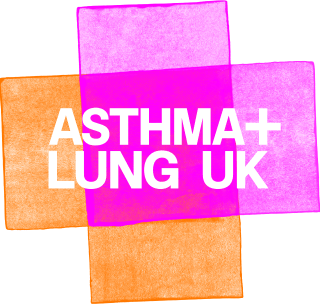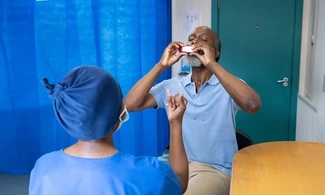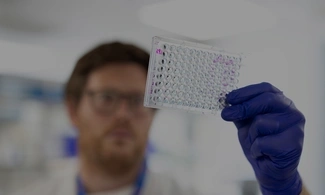- Why does my child need an inhaler?
- Why does my child need a spacer?
- What does my child's inhaler do?
- How do I know if my child's preventer medicine is working?
- How do I know if my child's reliever inhaler is working?
- What if my child needs their reliever inhaler more often?
- What if I forget to give my child their preventer inhaler?
- What if my child does not want to use their inhaler?
- Can my child use their reliever inhaler at school or nursery?
- Will my child always need an inhaler?
- Can my child's inhaler cause side effects?
- Common questions about children's steroids
- Why does my child need montelukast?
Why does my child need an inhaler?
Inhalers help your child breathe in their asthma medicine. This helps the medicine get right into your child’s lungs, where it’s needed.
If your child uses their inhalers as prescribed, and with the right technique, they can prevent asthma symptoms, like coughing, wheezing, a tight chest and breathlessness.
Why does my child need a spacer?
All children and adults should use a spacer with a pressurised metered dose inhaler (pMDI).
If your child does not use a spacer with a pMDI, only around 10% of medicine gets to their lungs. This is because pMDIs release the medicine quickly and it can stick to the back of their mouth and throat.
Spacers help your child breathe in their medicine more easily, so they get the full dose of their asthma medicine into their lungs. This also means they’re less likely to get side effects like a sore throat or oral thrush (a mouth infection).
- Babies and children under five years old may find it easier to use a spacer with a face mask.
- Children over five years old can try a spacer with a mouthpiece. Using a mouthpiece helps reduce the risk of redness or irritation around your child’s mouth, which can happen when using a face mask.
Your child does not need a spacer if they use a dry powder inhaler (DPI). If you’re not sure which type of inhaler or spacer is best, ask your child’s GP, nurse, or pharmacist for advice.
Watch our short videos to learn the best way to use a spacer with your child's inhaler.
What does my child's inhaler do?
Most children with asthma have two inhalers: a steroid preventer inhaler and a reliever inhaler.
- The steroid preventer inhaler helps prevent inflammation in your child’s airways.
- The blue reliever inhaler opens their airways if they have symptoms or an asthma attack.
Some children may benefit from a type of combination inhaler called MART (Maintenance and Reliever Therapy). This combination inhaler acts as a preventer and reliever inhaler, so your child does not need a separate blue reliever inhaler.
Read more about inhalers and how asthma is treated in children.
All children with asthma need steroid preventer medicine
To reduce inflammation and lower the risk of an asthma attack, your child needs to take a steroid preventer inhaler every day, as prescribed, even if they feel well.
If your child has a MART inhaler, it contains steroid preventer medicine and can treat inflammation in your child's airways.
Reliever inhalers treat symptoms when your child gets them. They can also treat an asthma attack if your child has one. But they cannot treat inflammation in your child's airways.
How do I know if my child's preventer medicine is working?
You’ll be able to see that your child’s steroid preventer inhaler is working well if they:
- have fewer symptoms
- do not need to use their reliever inhaler.
It can take a few days before you start to see the benefits of your child’s preventer inhaler.
Because it takes time to reduce inflammation in your child’s airways, it may be a few weeks before you see all the benefits.
If your child’s inhaler is still not helping their symptoms after a few weeks, speak with their GP or nurse for advice.
How do I know if my child's reliever inhaler is working?
You can tell if your child’s reliever inhaler is working if it helps them to breathe more easily when they have symptoms. This usually happens within a few minutes.
See a GP or nurse within 24 hours if your child’s symptoms get worse, or they’re still having symptoms after seven days.
What if my child needs their reliever inhaler more often?
If your child needs to use their reliever inhaler for asthma symptoms three or more times a week, speak to their GP or nurse.
This is often a sign that your child’s asthma is not well controlled, and they may be at risk of an asthma attack.
Check that your child is also taking their preventer medicine as prescribed. This will reduce inflammation in their airways and how often they need to take their reliever inhaler.
See a GP or nurse if your child needs to use their reliever inhaler three or more times a week.
What if I forget to give my child their preventer inhaler?
Don't worry if you forget to give your child their preventer or MART inhaler at the usual time. Just give them their inhaler as soon as you remember.
But if it’s time for them to take their next dose, do not give them two doses to make up for the one they missed.
Always try your best to get into a good routine with your child’s preventer inhaler, so it’s easier for you to remember.
You could:
- set daily reminders on your phone, calendar or use a medicine reminder app. The NHS also has a Health Medication Reminder Service.
- link when they take their inhaler to something else they do every day
- keep your child’s inhaler and spacer in the same place, somewhere both you and your child see every day.
What if my child does not want to use their inhaler?
We know from calls to our helpline that using an inhaler and spacer can be a scary and unfamiliar experience for some children.
It can take some time for your child to feel comfortable using their inhaler and spacer, but it does get easier with practice.
Some parents have told us they find it helpful to:
- pretend to take the inhaler themselves or give it to their child's favourite toy
- encourage their child to decorate their inhaler and spacer with stickers, or give it a fun name
- give their child a high-five, special handshake or dance after they use their inhaler.
If your child still doesn't want to use their inhaler, speak to their GP, nurse or pharmacist.
Find more tips to help your child use their inhaler and spacer.
Can my child use their reliever inhaler at school or nursery?
Your child should take their reliever inhaler and spacer with them to school or nursery. Some parents find it helpful to add a name label to their child’s inhaler and spacer.
Let the school or nursery know that your child has asthma and an inhaler, so staff can help if they have symptoms or an asthma attack.
Some schools and nurseries keep a spare emergency reliever inhaler that your child can use if they forget, lose or break their own inhaler. Because each school and nursery have different policies, it’s a good idea to ask if they have an emergency blue reliever available.
Read more about how to keep your child safe with asthma at school and nursery.
Will my child always need an inhaler?
Your child’s symptoms can get better when they get older or even go away completely, but it’s likely they’ll still need an inhaler. This is because inhalers help to prevent and reduce inflammation in their airways. It's the inflammation which causes your child's symptoms.
Take your child to their asthma review every year, even if they feel well, so their GP or nurse can check how well they're managing their asthma.
If your child has a good inhaler routine and their asthma is well-controlled, they may be able to take a lower dose of asthma medicine.
Can my child's inhaler cause side effects?
As with many medicines, inhalers can cause side effects, but not everyone gets them.
Side effects depend on the type of inhaler and how much medicine it contains.
Your child can prevent common side effects by:
- using their inhaler correctly
- using a spacer if they have a type of inhaler called a pMDI (pressurised metered dose inhaler)
- rinsing their mouth with water and spitting it out.
Read more about possible side effects of preventer inhalers, reliever inhalers and combination inhalers.
Common questions about children's steroids
The latest guidelines recommend that all children with asthma take a low dose of steroid preventer medicine to treat the inflammation in their airways.
The steroids in your child's preventer inhaler are called inhaled corticosteroids (ICS).
Steroids in preventer inhalers are a copy of the ones that your body makes naturally. They’re not the type that some people take to build muscle.
The dose in your child’s inhaler is low and unlikely to cause harmful side effects.
Inhaled steroids work by reducing inflammation in your child’s airways. This helps prevent asthma symptoms and attacks.
Sometimes your child’s asthma symptoms might get worse, even if they’re using their inhalers as prescribed. If that happens they might need a higher dose of steroids in their preventer inhaler.
Their GP or nurse will always try to prescribe the lowest dose of steroids to manage your child’s asthma symptoms.
Taking a steroid preventer inhaler regularly helps to:
- manage inflammation in your child's airways
- reduce the risk of symptoms and asthma attacks
- reduce the need for a higher dose of steroids in your child's inhaler or steroid tablets to help manage a flare-up.
Your child may have a one-off course of steroid tablets to help treat inflammation in their airways if:
- they have an asthma attack
- their symptoms are not well-controlled by their steroid preventer inhaler.
Steroid tablets can help your child to get better more quickly and prevent them from having more serious symptoms. Steroid tablets are unlikely to cause any side effects over a short period of time.
How long your child takes steroid tablets for will depend on the reason they’re taking them.
If your child has two or more courses of steroids in a year, they should see an asthma specialist. Regular reviews with an asthma specialist help to make sure your child’s taking the right dose of steroids to manage their symptoms.
Find out more about short and long-term courses of steroid tablets.
Some parents tell us that they notice a change in their child’s mood when they take steroid tablets, like prednisolone. They might become more upset, angry or have mood swings.
These side effects should pass but speak to a GP or nurse if you notice any changes in your child. It’s important that your child does not stop taking steroid tablets suddenly to reduce the risk of any side effects.
If your child has been taking steroid tablets for more than two weeks, their GP or nurse can reduce the dose gradually before they come off them completely.
If your child takes a high dose of steroid medicine for a long time, there’s a very small risk that it can affect their growth by a very small amount.
It also depends on when your child starts taking steroids, what dose of steroids they’re on, and how long they need to take them.
This can be worrying, but research has shown that untreated asthma can affect your child’s growth slightly more than taking steroid medicine.
Your child’ GP or nurse will check their height at least once a year at their asthma review.
Taking a high dose of steroid medicine for a long time can increase your child’s appetite, which can lead to them gaining a small amount of weight.
If this is something you’re worried about, you can help by encouraging healthy eating habits and regular physical activity.
You might also feel reassured to know that your child’s GP or nurse will check your child’s weight at least once a year at their asthma review.
Steroids can affect the immune system, but the risk depends on the type and dose your child’s taking.
- Inhalers: Most children take a standard dose of inhaled steroids for asthma. They do not usually increase your child’s risk of infections, such as chickenpox or measles. If your child is taking a high dose of inhaled steroids, they may have a slightly higher risk of infection.
- Steroid tablets: Children who need steroid tablets, especially for longer periods of time, are at higher risk of serious infection. Infections like chickenpox and measles can be more severe for these children.
It’s important to make sure your child’s up to date with their vaccines, including the MMR vaccine (measles, mumps and rubella) to protect them. If your child has never had chickenpox, they should avoid close contact with people who have chickenpox or shingles.
If your child’s taking steroids and has been in contact with someone with chickenpox or shingles, speak to their GP, nurse or specialist straight away for advice.
Most children with asthma take a low dose of steroid medicine and do not need to carry a steroid card.
Your child may need a steroid card if they take:
- a high dose of steroids in their preventer inhaler
- steroid tablets for more than three weeks
- more than one medicine that contains steroids, such as a steroid inhaler and nasal spray or steroid cream.
Steroid cards are helpful if your child goes to hospital because they’re unwell or they’ve had an accident. It also tells healthcare professionals what steroids your child is taking.
This means the healthcare professional can check your child is taking the right type and amount of steroid medicine.
Your child’s GP or nurse can tell you if they need a steroid card. Pharmacists can also give you a steroid card if needed.
Read more about steroids and steroid cards.
Why does my child need montelukast?
Montelukast helps prevent inflammation in your child’s airways and asthma symptoms.
It’s an add-on treatment that can help your child’s symptoms without increasing the steroid dose in their preventer inhaler.
If your child takes the preventer inhaler as prescribed and they still have symptoms, their GP or nurse may prescribe montelukast.
Read about montelukast and side effects to look out for.

Get support
Our helpline is closed from 1pm on Wednesday 24th December 2025 and re-opens at 9:15am on Friday January 2nd 2026. Our supporter care line is also unavailable during this period. If you have a flare-up of your lung condition symptoms, contact your GP or healthcare professional or 111 for advice. Always dial 999 in an emergency.








